In recent years, countries across geographies have been working on expanding their digital footprint, becoming more data-driven, higher-performing, and better connected. In addition, the pandemic increased pressure on businesses to enhance automation and agility, deliver enhanced customer experience, and adopt remote work culture. Also, there has been a push to implement cloud-based business continuity tools and services, which drove the cloud market growth. What are today's security challenges and trends in cloud computing across the globe? Read on to find out!
In 2018, 71% of online U.S. respondents to Statista's Global Consumer survey said they used a cloud storage service for a wide range of purposes — from personal to professional, from entertainment to education. In 2020, GoodFirm Research showed that 92.59% of people were using the cloud for storing office data and 72.69% of them as a medium for sharing files. Moreover, more than 50% of people utilized at least three data storage services.
As of 2022, following the Cloud Security report, almost 40% of corporate data is stored in the cloud, and 76% of enterprises use two or more cloud providers.
Nowadays, 79% of respondents globally believe that application workloads will move freely across clouds in the future (survey). However, despite the meteoric rise of cloud services' popularity worldwide, the intensity of this rise differs from country to country.
The North American Region Is the Largest in the Global Cloud Services Market
While we await their 2023 report, analyzing the data from the Global Cloud Ecosystem Index 2022 (rating of 76 countries and territories according to how well technology, regulations, and talent promote the availability of cloud services). It has been revealed that the North American region is the most conducive to cloud computing with an average Index score of 7.65.
However, we should remember that according to the data, only two countries — the USA and Canada — are included in the region (Mexica and Central American countries categorically belong to the Latin America and Caribbean region).
At the same time, according to the data presented in the Cloud Services Global Market Report 2021, the North American region took the largest share (61%) in the global cloud services market in 2020. As Cloud Computing Market Report 2022 demonstrates, the region has also captured the highest ratio in 2022 since the USA and Canada are rapidly adopting cloud computing and experiencing significant technological innovations. The majority of key market players, namely, seven out of every ten companies, are located in the USA, including three leading cloud service providers — Amazon, Microsoft, and Google.
Although Amazon's spendings on its cloud service are the largest on the market (e.g., 32% on AWS in comparison with 22% on Microsoft Azure and 9% on Google Cloud in the 3rd quarter of 2022, according to Canalys), Google Drive is by far the most used cloud storage service in the world, following by Dropbox (Dropbox Inc. is also located in the USA) and Microsoft's OneDrive (according to Cloud Gaming Market Report 2021).
Therefore, it is unsurprising that these three services are among the top 10 cloud storage providers for 2022 (according to the justified Cloudward's rating), along with American IDrive, Box, and Canadian Sync.com.
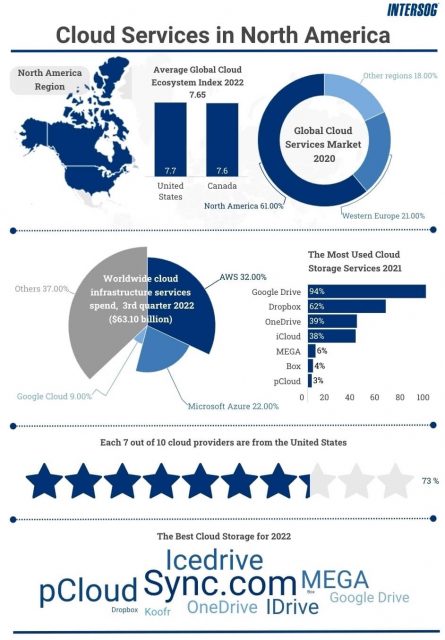
European Countries Are the Most Favorable to Cloud Services
Western Europe took a three times smaller share (21%) of the global cloud services market than the North American region, yet it ranks second in the world; European digital practices promoting the use of cloud models are still at a high level.
The Global Cloud Ecosystem Index 2022 is rating 28 countries in Europe and Central Asia, considering them as one region. Although the region includes five countries with a middle income, its average Index value is 7.45, which is close to the Index value of the North American area.
Moreover, nine out of the ten countries with the highest Index value worldwide are European (Finland - 8.5, Sweden - 8.4, Denmark - 8.3, Switzerland - 8.3, Germany - 8.1, Iceland - 8.1, France - 8.1, Norway - 8.1, and Luxemburg - 8.0) that makes Central and North European countries the most appealing for cloud computing. Europe is also a motherland of pCloud (Switzerland), IceDrive (U.K.), and Koofr (Slovenia), which are among the top 10 cloud storage providers.
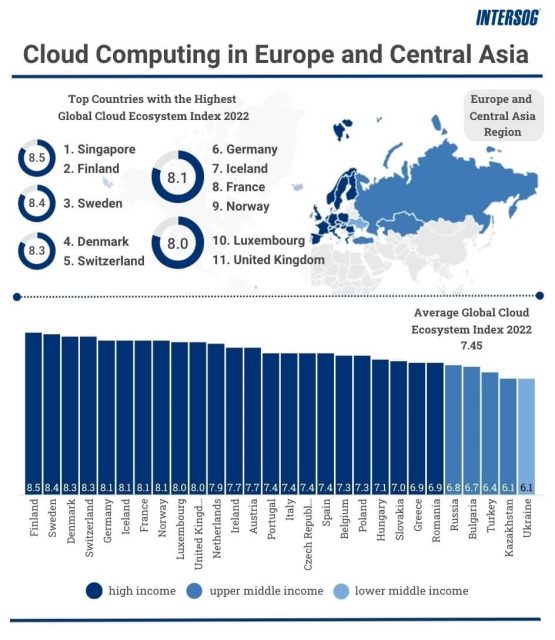
Singapore Is the Most Cloud-Friendly Country in the World
Based on the average Index score in the East Asia and Pacific region, which is 7.0, it keeps the third position among the seven areas according to the data. Along with European Finland, whose Index score is the highest, the global leadership also belongs to the East Asian country — Singapore, whose Global Cloud Ecosystem Index score is the same — 8.5. However, the Chinese (the Index is 6.5) cloud market is still the biggest in the region.
In 2019 China's total cloud infrastructure services expenditure was $11.5 billion, and in 2020 it grew by 66% ($19 billion), according to Canalys. As a result, cloud infrastructure spending in China reached $7.8 billion in the third quarter of 2022, which is 12% of overall global cloud spending. Additionally, one of the ten best cloud providers, Mega, is originally from the East Asia and Pacific region (New Zealand); it keeps the fifth position among the most used cloud storage services.
Chinees cloud service provider Alibaba Cloud grew 54% in the fourth quarter of 2020 to account for 6% of the total market and took the fourth leading position in the cloud market (as per Canalys). It remained the leading cloud service provider in the Asia Pacific region with 36% of cloud infrastructure services spendings in the third quarter of 2022 (Canalys), followed by the other leaders of this region — Huawei Cloud (19%), Tencent Cloud (16%), and Baidu A.I. Cloud (9%).
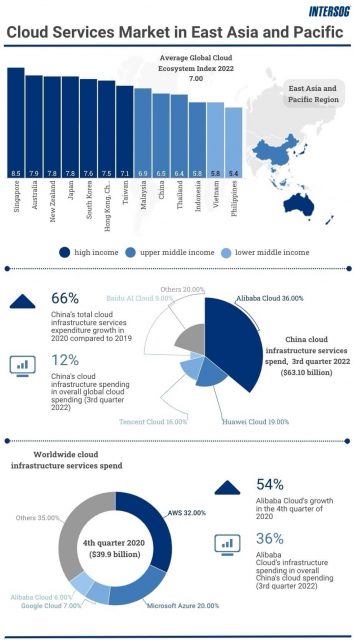
Cloud Adoption in the Middle East and Latin America Regions Is Rising
Two regions — the Middle East and North Africa, along with Latin America and the Caribbean — are in the middle of the rating with their average scores on the Global Cloud Ecosystem Index 5.8 and 5.6, respectively.
Moreover, some countries are beyond this interrelation despite the correlation between Index score and income level. Thus, Kuwait, Qatar, and Saudi Arabia have lower scores on the Index than some countries with lower incomes. Still, a more positive predisposition to cloud services (for example, Bulgaria, Malaysia, Thailand, Turkey, and Russia).
Despite the low levels of the Index, the use of the cloud in these regions exponentially grows, fostered by the pandemic, which gave the already-expanding cloud sectors more fuel. In addition, investments in the I.T. sector of Middle Eastern countries (mainly in Saudi Arabia, UAE, and Qatar) have been tremendous since these governments are keen to make all departments and services online.
Equally, driven by rising cloud adoption in growing markets, such as Mexico, Colombia, Chile, El Salvador, Guatemala, Peru, and others, Latin America has become a burgeoning center of cloud-based digital transformation.
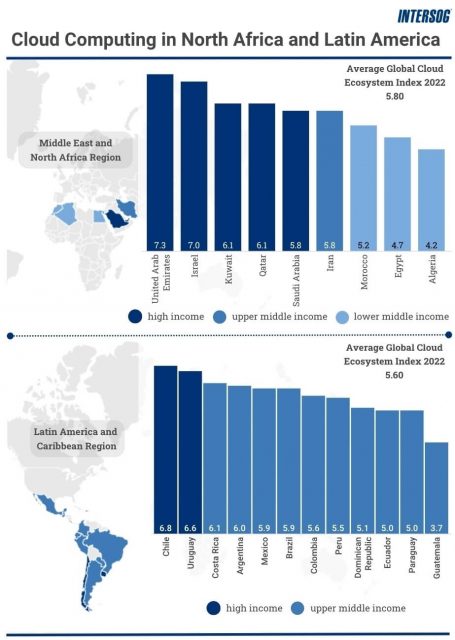
South Asian and Sub-Sahara African Economies Are the Weakest for Cloud Technologies Implementation
Technology, regulations, and talent of the South Asia and Sub-Saharan Africa regions at the lowest level promote the availability of cloud services, with average Global Cloud Ecosystem Index scores of 4.47 and 3.99, correspondingly.
The share of the African region in the global cloud services market is the smallest (as per the report) since its cloud services sector is in its early stages of development. Furthermore, the economy of Ethiopia is the least supporting cloud computing in the rating (Index score is 2.7).
Nonetheless, the impact of cloud services in African counties is already far-reaching: new partly cloud-based "digital banks" are emerging; public service delivery is enhanced through the cloud; compute capabilities are used in retail; scores of African cloud-native startups are leveraging the cloud to disrupt entire industry sectors (as per this report). The same situation is in the South Asia region. Thus, the ongoing digital developments in these areas highlight the transformative potential of cloud computing.
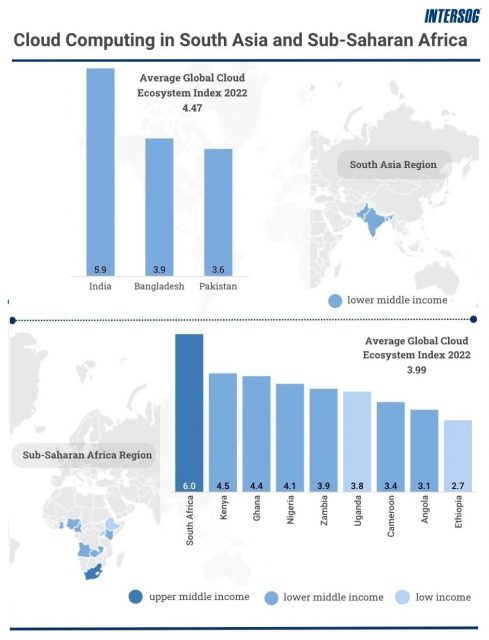
Security Is the Biggest Challenge of Using Cloud Computing Technology
Among commonly cited challenges indicated by technical executives, managers, and practitioners of cloud technologies during a survey, security was defined as the most significant challenge (as per 85% of responders) of using cloud computing technology, followed by managing cloud spending, governance, and lack of resources/expertise.
56% of global respondents during Thale's Survey of data threats identified the malware as the type of attack in which they'd seen the highest increase in activity. Ransomware ranked second (53%), and phishing/whaling rounded out the top three (40%). 'Accidental human error,' at the same time, was in the top four threats of 78% of responders.
According to the 2022 CISO Research Report, 61% of organizations have a layered cybersecurity posture supported by five or more security solutions. The most common usage (over 50% of cases) is antivirus scanning, email security/encryption, web application firewall, and data encryption. Additionally, 40% of respondents said they had avoided a breach notification because underlying data was encrypted or tokenized (as per the 2022 Thale Data Threats Report).
Nevertheless, 75% of CISOs (chief information security officers) say there are still gaps that allow vulnerabilities into production (2022 CISO Research Report). Furthermore, 80% agree that security must be a shared responsibility to drive effective vulnerability management in the age of cloud-native delivery.

Global Cloud Computing Is Going To Grow
The cloud has become a critical part of many business operations and is likely to continue to play a central role in the future.
Cybersecurity Ventures predicts that global data storage will exceed 200 zettabytes by 2025, with 50% stored in the cloud. In addition, 58% of responders (the Cloud Security report) plan to hold more than 50% of their data in the cloud in 2023. In this age of digitization, organizations are encouraged to shift to the cloud for cost-effective and flexible big data storage options on an on-demand basis. Thus, governments across countries are investing in cloud-computing delivery models.
According to the forecast by Gartner, Inc., worldwide end-user spending on public cloud services is expected to reach nearly $600 billion in 2023. The new reality of hybrid work is prompting organizations to move toward DaaS (device as a service), driving spending to reach $3.2 billion in 2023.
In addition, demand for cloud-native capabilities by end-users accounts for PaaS (platform as a service) predictions are growth to $136.4 billion in spending.
However, SaaS (software as a service) remains the most prominent public cloud services market segment, forecasted to reach $208.1 billion in end-user spending in 2023.
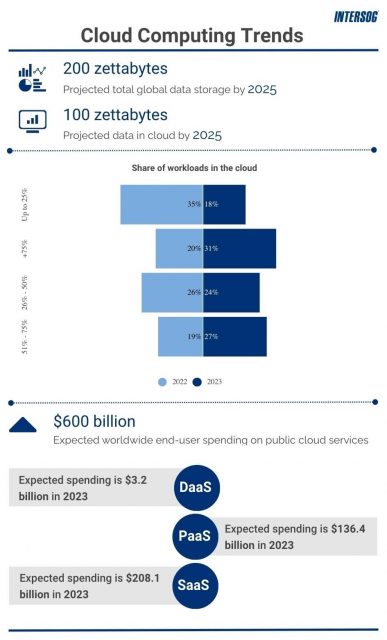
The Cloud Recap
The cloud is growing increasingly popular every year, helping businesses become more efficient and letting employees work from anywhere at any time. Cloud adoption and innovation are very prominent in the United States. Thus, the North American region takes the largest share of the cloud services market. The leading cloud services vendors, providing the most usable cloud storage, are in this region.
Meanwhile, European countries and Singapore's regulatory frameworks and digital practices that promote the use of cloud models in public and private sectors are at the highest level per Global Cloud Ecosystem Index 2022.
The Chinese cloud market is blooming, and the rest of the world is catching up. Many organizations and governments overseas are working to develop their cloud systems and data centers.
Although cloud storage offers enormous benefits for organizations of all sizes, it also comes with challenges - many organizations are concerned about cloud security. Nonetheless, the cloud's importance cannot be overestimated. Cloud technologies of all types and models will only become much greater and more essential in the years to come.
Intersog has been helping our clients for years moving IT services to the cloud. We can shore up your infrastructure and devops capabilities as required. All you have to do is ask! So don't shy away from today's security challenges and trends in cloud computing. We have most of the mysteries solved.







